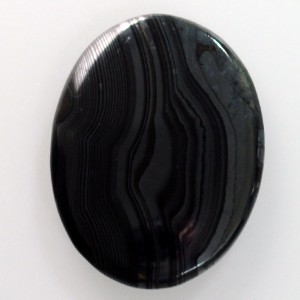- NEW DVD Series – Stone Setting with Bezels
- Tube Set Charm by Kim St. Jean
- Prong Basket Pendant by Kim St. Jean
- NEW DVD Series – Stone Setting with Cold Connections
- New DVD Series – Stone Setting with Wire
- NEW DVD Series: Introduction to Stone Setting by Kim St. Jean
- Featured Tool: Bracelet Bending Plier
- NEW Dvd by Eva Sherman
- Fun, Fast Fold Forming DVD Series
- Double Band Ear Cuff from Alex Simkin
Gem Profile July 6: Psilomelane
by Rose Marion, Wire-Sculpture.com

Psilomelane
Psilomelane, also rarely called psilomelanite and black hematite, is an umbrella name for manganese oxides, which are black stones. The name was chosen in 1758 and comes from the Greek for "smooth" (psilos) and "black" (melas – like melanin gives a dark pigment). I’m sure you’ve seen this stone if you’ve been to Tucson or any large gem shows: psilomelane looks like a black, almost metal, slice of wood. Gem-quality psilomelane, often called crown of silver psilomelane or silver crown psilomelane, is polished so you can see silvery "wood grain" or "tree rings" on a jet-black background. Some people even call it "black malachite," although the two stones aren’t related. The name comes from the Silver Crown Mine that it is found in, in Chihuahua, Mexico, which has been open rarely in the last 100 years, closing due to WWII and multiple cave-ins. While there was much mining in the 1950s and some in the early 2000s, it is still a rare find on the lapidary market.
The silvery portions, which can look black, silver, or blue depending on the angle of light, are made up of pyrolusite, which is a different manganese oxide. Pyrolusite is used in making other alloys, creating chlorine, and used in disinfectants, taking green and brown tints out of glass, and in calico printing and dyeing. It is not magnetic, despite its hematite-like appearance. It can even be used in batteries, although artificial substitutes are more common.
(source)
Psilomelane is softer than quartz, about a 5 to a 6 on Mohs scale. It’s often found in grape-like botryoidal formations, but you can see this unusual psilomelane sample that formed with black hair-like crystals on the top. That’s a very close-up look: the crystals are less than a quarter-inch tall!
Besides the Silver Crown Mine in Chihuahua, Mexico, there aren’t many active centers of gem-grade psilomelane mining. Augusta County, Virginia once had a mine, Crimora, which is now abandoned. Psilomelane has also been found in Arizona, New Mexico, Montana, and Arkansas in the US, and in small pockets of Europe, Africa, Asia, Australia, and Europe.
Sometimes you will see psilomelane stones that have clear parts between the "grain," even druzy sometimes. (See an example here, courtesy of GreatRough.com) This clear area is chalcedony, and some call it manganese oxide in quartz. Chalcedony psilomelane can turn into beautiful cabochons.
Metaphysically speaking, psilomelane is said to aid in understanding our emotional patterns and empowering us to re-engrave those grooves.
Next week we’ll explore another well-known black chalcedony relative: onyx. Have you made wire jewelry with onyx, in any color? Send your Onyx pictures to tips@wire-sculpture.com, and they could be featured!
Resources & Recommended Reading
- Pyrolusite on Wikipedia
- Psilomelane on MinDat
- Psilomelane on WebMineral
- Psilomelane on Wikipedia
- Psilomelane on GreatRough
- Psilomelane, Central Michigan University
- Cryptomelane
- Crown of Silver Psilomelane
Gem Profile by Rose Marion
Click to Receive Daily Tips by Email





















Brenda Norwick
July 6, 2012 at 6:16 am
Can you please give us the pronunciation of this stone, and
the many other stones that you have already published which
are not obvious. Perhaps a video naming the many stones already covered.
DeLane
July 6, 2012 at 7:32 am
I purchased some Silver Crown Psilomelaine this year in Tucson. The seller called it “The Ugly Black Stone.” But, I like it, and I think it looks elegant, with its oil-on-water designs. It will make a beautiful, elegant cabochon for some lady to wear. I will admit, the seller warned about cutting the slab I purchased, stating that it is extremely dirty to work with, and most difficult to get out of the pores of the skin after cutting it. I will still make the cab and wire wrap it.
Lynne Clark
July 6, 2012 at 8:35 am
It would help if the Gem Profiles contained how the gem is pronounced.
Rose
July 10, 2012 at 2:10 pm
Hi Brenda and Lynne, that never occurred to me, thanks for the suggestion!
As far as psilomelane, I haven’t heard anyone say it so I’m not sure – but I would guess “si-la-mi-lane.” I’ll have to ask around – thanks!